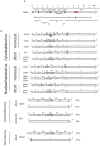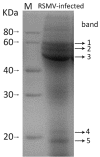Rice Stripe Mosaic Virus, a Novel Cytorhabdovirus Infecting Rice via Leafhopper Transmission
- PMID: 28101087
- PMCID: PMC5210121
- DOI: 10.3389/fmicb.2016.02140
Rice Stripe Mosaic Virus, a Novel Cytorhabdovirus Infecting Rice via Leafhopper Transmission
Abstract
A new rice viral disease exhibiting distinct symptoms-yellow stripes, mosaic and twisted tips on leaves-was found in China. Electron microscopy of infected leaf cells revealed the presence of bacilliform virions and electron-translucent granular-fibrillar viroplasm in the cytoplasm. The enveloped viral particles were 300 to 375 nm long and 45 to 55 nm wide. The leafhopper Recilia dorsalis was able to transmit the virus to rice seedlings, which subsequently exhibited symptoms similar to those observed in fields. The complete genome of the virus was obtained by small-RNA deep sequencing and reverse transcription-PCR product sequencing. The anti-genome contains seven open reading frames (ORFs). The deduced amino acids of ORF1, ORF5, and ORF7 are, respectively, homologous to the nucleocapsid protein (N), glycoprotein (G), and large polymerase protein (L) of known rhabdoviruses. The predicted product of ORF2 is identified as a phosphoprotein (P) based on its multiple potential phosphorylation sites and 12.6 to 21.0% amino acid (aa) identities with the P proteins of plant rhabdoviruses. The product of ORF4 is presumed to be the viral matrix (M) protein for it shares 10.3 to 14.3% aa identities with those of other rhabdoviruses. The above five products were confirmed as the viral structural proteins by SDS-PAGE and aa sequencing analyses of purified virus preparation. ORF3 and ORF6 are considered to encode two nonstructural proteins with unknown functions. Phylogenetic analysis based on protein N, G, and L amino acid sequences indicated that the isolated virus, which we have tentatively named Rice stripe mosaic virus (RSMV), is a new species in the genus Cytorhabdovirus. To our knowledge, RSMV is the only cytorhabdovirus naturally infecting rice and the first reported leafhopper-transmitted cytorhabdovirus. Our surveys of rice fields indicate that RSMV occurs frequently in Guangdong Province, China. Although the disease incidence is low at present, it might become serious with the vector insect population increasing.
Keywords: Recilia dorsalis; Rice stripe mosaic virus; cytorhabdovirus; leafhopper; rice viral disease.
Figures





Similar articles
-
Infection Characteristics of Rice Stripe Mosaic Virus in the Body of the Vector Leafhoppers.Front Microbiol. 2019 Jan 8;9:3258. doi: 10.3389/fmicb.2018.03258. eCollection 2018. Front Microbiol. 2019. PMID: 30671049 Free PMC article.
-
Double-Stranded RNA High-Throughput Sequencing Reveals a New Cytorhabdovirus in a Bean Golden Mosaic Virus-Resistant Common Bean Transgenic Line.Viruses. 2019 Jan 21;11(1):90. doi: 10.3390/v11010090. Viruses. 2019. PMID: 30669683 Free PMC article.
-
Transmission Biology of Rice Stripe Mosaic Virus by an Efficient Insect Vector Recilia dorsalis (Hemiptera: Cicadellidae).Front Microbiol. 2017 Dec 11;8:2457. doi: 10.3389/fmicb.2017.02457. eCollection 2017. Front Microbiol. 2017. PMID: 29312171 Free PMC article.
-
Rice Stripe Mosaic Disease: Characteristics and Control Strategies.Front Microbiol. 2021 Jul 29;12:715223. doi: 10.3389/fmicb.2021.715223. eCollection 2021. Front Microbiol. 2021. PMID: 34394065 Free PMC article. Review.
-
Plant rhabdoviruses.Curr Top Microbiol Immunol. 2005;292:143-63. doi: 10.1007/3-540-27485-5_7. Curr Top Microbiol Immunol. 2005. PMID: 15981471 Review.
Cited by
-
A Review of Vector-Borne Rice Viruses.Viruses. 2022 Oct 14;14(10):2258. doi: 10.3390/v14102258. Viruses. 2022. PMID: 36298813 Free PMC article. Review.
-
Discovery and Genomic Function of a Novel Rice Dwarf-Associated Bunya-like Virus.Viruses. 2022 May 29;14(6):1183. doi: 10.3390/v14061183. Viruses. 2022. PMID: 35746655 Free PMC article.
-
Infection Characteristics of Rice Stripe Mosaic Virus in the Body of the Vector Leafhoppers.Front Microbiol. 2019 Jan 8;9:3258. doi: 10.3389/fmicb.2018.03258. eCollection 2018. Front Microbiol. 2019. PMID: 30671049 Free PMC article.
-
Identification and Characterization of Wheat Yellow Striate Virus, a Novel Leafhopper-Transmitted Nucleorhabdovirus Infecting Wheat.Front Microbiol. 2018 Mar 14;9:468. doi: 10.3389/fmicb.2018.00468. eCollection 2018. Front Microbiol. 2018. PMID: 29593700 Free PMC article.
-
Different viral effectors suppress hormone-mediated antiviral immunity of rice coordinated by OsNPR1.Nat Commun. 2023 May 25;14(1):3011. doi: 10.1038/s41467-023-38805-x. Nat Commun. 2023. PMID: 37230965 Free PMC article.
References
-
- Bejerman N., Giolitti F., de Breuil S., Trucco V., Nome C., Lenardon S., et al. (2015). Complete genome sequence and integrated protein localization and interaction map for alfalfa dwarf virus, which combines properties of both cytoplasmic and nuclear plant rhabdoviruses. Virology 483 275–283. 10.1016/j.virol.2015.05.001 - DOI - PubMed
-
- Bheemanahalli R., Sathishraj R., Tack J., Nalley L. L., Muthurajan R., Jagadish K. S. V. (2016). Temperature thresholds for spikelet sterility and associated warming impacts for sub-tropical rice. Agric. For. Meteorol. 221 122–130. 10.1016/j.agrformet.2016.02.003 - DOI
LinkOut - more resources
Full Text Sources
Other Literature Sources

